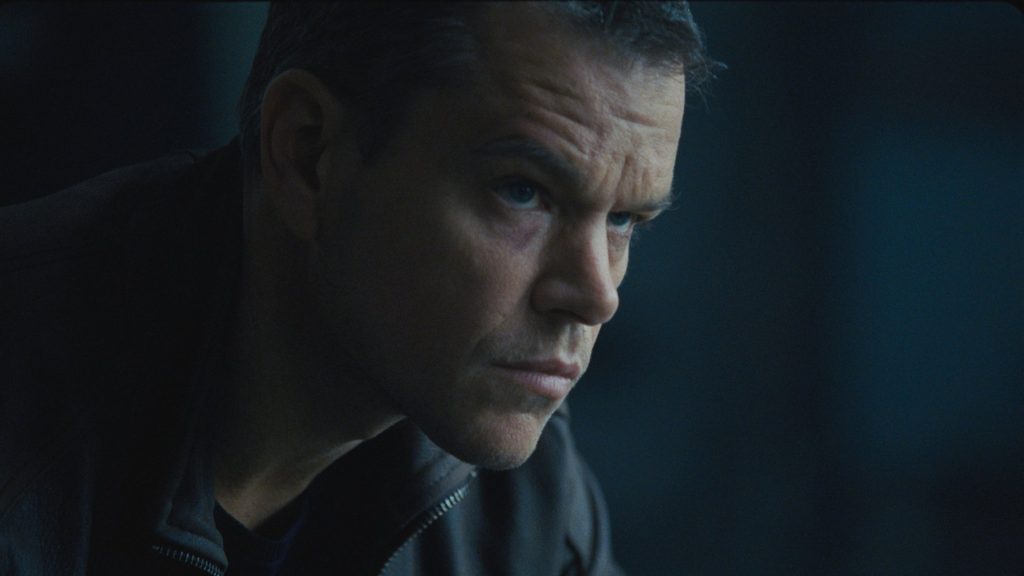
Matt Damon in Jason Bourne (2016). Photo credit: Universal Pictures
We love the excitement of a thriller. Its plot twists, mistaken identities, savage villains and high anxiety brought on by the element of suspense gets our blood racing. To help us relate to the protagonist (and up the terror), he is usually an “every man,” someone just like you or me, compelling us to coldly consider that the same terrible event happening onscreen could easily happen to us.
Sign up for ScreenwritingU’s Mystery, Intrigue and Suspense: Mastering the Thriller Genre class
When a thriller works, it’s like a roller coaster with a surprise curve at the end. The ups and downs of the protagonist’s struggle should leave the audience emotionally exhausted. This is one genre of film that will never go out of favor in Hollywood — as long as the story feels fresh.
Let’s take a look at some of the thriller subgenres that define a particular style and tone of the film. Keep in mind that many of the subgenres often cross over.
No. 1 — Action Thriller
The Bourne Identity, Taken, Mission Impossible and any of the James Bond films can be described as action thrillers. The audience expects the protagonist to physically fight for his survival and find himself in grave physical danger repeatedly throughout the film. Also, there are typically many locations, travel by numerous high-speed vehicles and the presence of lots of guns and explosions. The action thriller should be fast, bold and loud, like an adrenaline rush.
Angelina Jolie in Salt. Photo courtesy: Sony Pictures
No. 2 — Spy Thriller
Bridge of Spies, Salt, North by Northwest, Munich, Mission Impossible and any of the James Bond films can be called a spy thriller. While there is typically plenty of action, the focus of the film is usually on a large-scale conspiracy involving governments, cover-ups and sophisticated weaponry. Spy thrillers are often set during a war, like the recent film Allied, where the entire world order is at stake.
Janet Leigh in Psycho. Photo courtesy: Paramount Pictures
No. 3 — Psychological Thriller
Psycho, Memento, Black Swan, Repulsion and The Shining are all great psychological thrillers because they portray characters who lose their grip on reality. These type of movies are the ultimate mind-f***, and usually have a big reveal at the end. Sexual repression and guilt are big components to the psychological thriller. Alfred Hitchcock is widely considered the master of the psychological thriller because he understood the dark side of humanity, also called “the shadow” by Carl Jung.
Inception. Photo courtesy: Warner Bros.
No. 4 — Sci-Fi Thriller
Alien, Blade Runner, Inception, The Matrix and Interstellar all fit into the genre of sci-fi thriller because they involve space travel, time travel or are set in futuristic, dystopian worlds. Often, these sci-fi thrillers are a cautionary tale of all the bad things that can happen if technology goes out of control.
Michael Douglas and Glenn Close in Fatal Attraction. Photo courtesy: Paramount Pictures
No. 5 — Sexy Thriller
Fatal Attraction, Basic Instinct, Body Double and Sea of Love are all thrillers that involve sex, obsession, betrayal and murder. Typically the story revolves around a man who allows his sexual desire to go unchecked and gets involved with the wrong woman who’s usually a blonde. He must then suffer serious consequences for his transgression. The protagonist is usually a man because in American culture, women are seen as less driven by their sexual desires and are expected to be the moral center of society. Passion and Unfaithful are two rare films where the sexual offence is committed by a woman.
Bruce Willis in Die Hard. Photo courtesy: 20th Century Fox
No. 6 — Crime or Heist Thriller
The Italian Job, Die Hard, Silence of the Lambs, Sicario and Cape Fear are all films that involve either planning a crime or solving a crime. The detective may be a real agent of the law, like in Seven, or just a regular Joe who unwittingly gets drawn into solving a crime, like Rear Window. Either way, the “detective” finds himself in a wholly new and dangerous situation and feels in way over his head. There is also a built-in ticking clock because he only has so much time before the killer/robber strikes again.
A Nightmare on Elmstreet. Photo courtesy: New Line Cinema
No. 7 — Horror Thriller
28 Days Later, A Nightmare on Elm Street, The Ring and World War Z all qualify as horror thrillers due to their frightening supernatural or darkly fantastical elements. This is the realm of nightmares where the protagonist must not only survive, but outwit and out-battle the antagonist using inferior weaponry.
Jaws. Photo courtesy: Universal Pictures
No. 8 — Man vs. Nature/Disaster Thriller
The Revenant, Jaws, San Andreas, Godzilla, Planet of the Apes and All is Lost are movies where humans are put to the test by the dark side of nature — in the form of a beast or natural disaster. The thrills from these movies are powerful because they play on primordial fears – a bear or shark attack, an earthquake, getting lost at sea are all universally scary. The key to these films is making the natural component seem as realistic as possible – then stacking the odds against the protagonist. In Lifeboat, not only are the characters drifting aimlessly at sea, there is also a Nazi onboard, adding to the danger.
What kind of thriller are you writing? Let us know below.